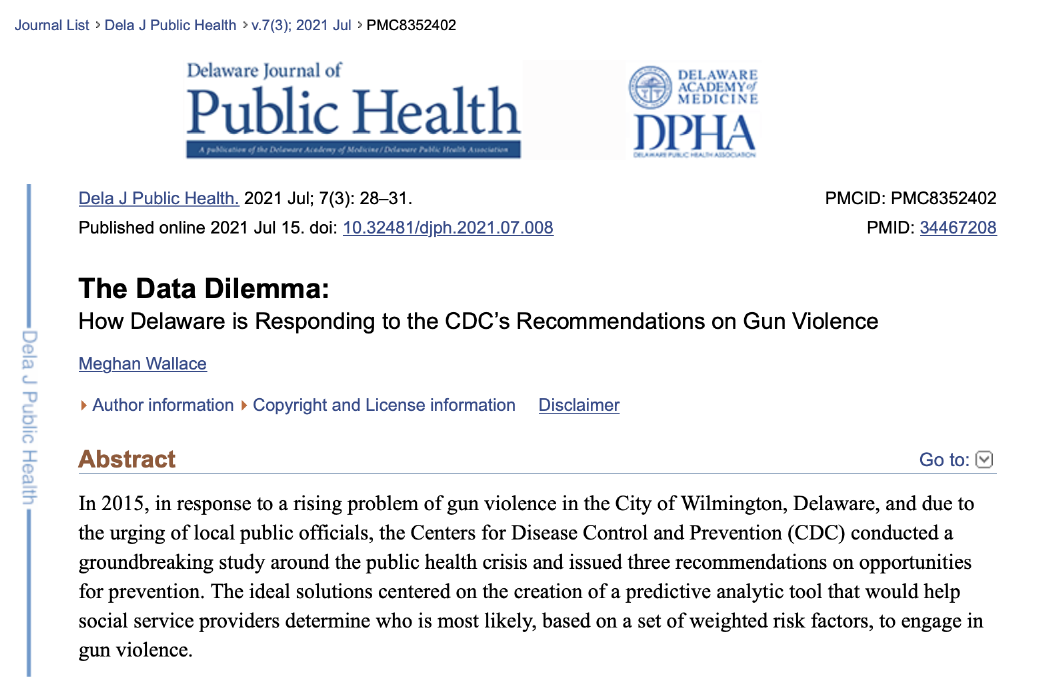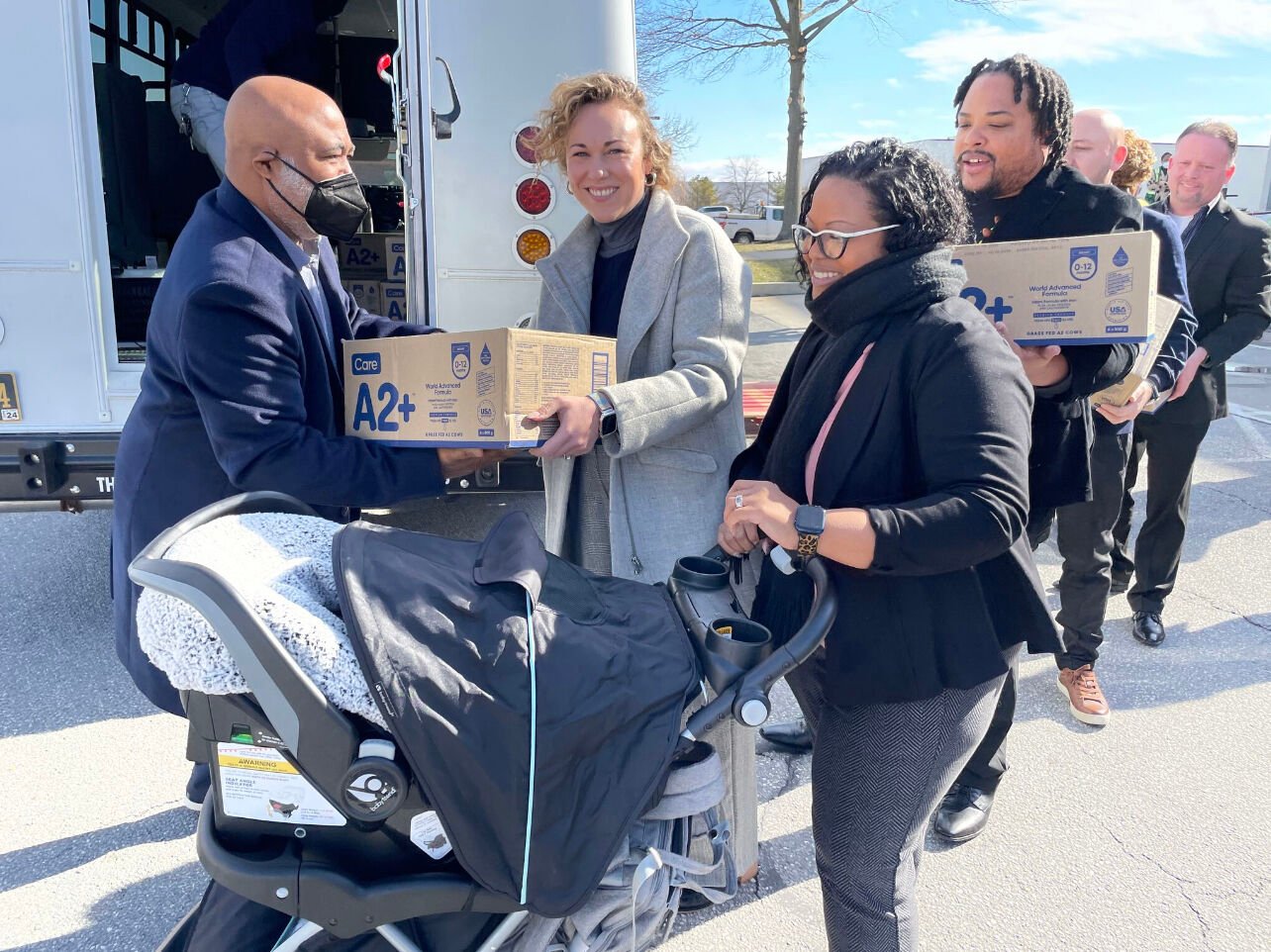Introduction
The modern world is a testament to the power of technology, especially in health care, education, and transparent access to information. There’s no doubt technology can improve lives. But with the immense potential technology presents, it’s important to consider any unintended impact of executing an idea.
In 2013, City Council asked the Centers for Disease Control and Prevention (CDC) to take a deep look at youth gun violence in Wilmington. As a result of the study, the CDC made three recommendations for how the city could prevent individuals from committing gun crimes. One of these focused on the creation of a data-sharing tool that would use predictive analysis to identify at-risk youth using key areas like Social Determinants of Health (SDOH) and collaboration between courts, hospitals, and schools.
At the time, Social Contract, a Wilmington-based consulting firm that partners with community, corporate, government, and philanthropic leaders to design and implement solutions to complex social challenges, was brought in to support the newly re-enacted Family Services Cabinet Council.1 The organization has a commitment to building authentic solutions, driven by meaningful engagement directly with the communities meant to be served. They believe that people can (and must) be part of the design phase, implementation, testing, and iteration of any solution, including technology tools.
For this effort, Social Contract saw the need for any solution, whether powered by technology or by people, to impact the behavior of the people who are most at risk of committing gun violence.
Over the course of the next few years, Social Contract engaged leaders, both at the state level, as well as on the ground, that helped stakeholders navigate roadblocks to implementing the CDC’s exact recommendations and ideate actionable solutions. Because the CDC recommendations presented technology as the primary solution to a deeply complex human problem, Social Contract’s integration of the human experience was critical in building solutions that could work in Wilmington and beyond. As the organization dug deeper, it became clear that to be truly effective, there would need to be a technology solution paired with meaningful service delivery to those most directly impacted by the epidemic of violence in Wilmington.
Mapping a Path Forward
The CDC’s report, Elevated Rates of Urban Firearm Violence and Opportunities for Prevention,2 marked the first time the CDC had “provided technical assistance to study the impact of gun violence as a public health issue.”3 By “analyzing shootings with the same methods used to study diseases and infections, researchers identified risk factors in the lives of those involved in violence. They recommended the state integrate its social service, criminal justice, school and other databases to better identify who could be next — and target them with comprehensive services to prevent another injury or death.”4
Specifically, the CDC’s report recommended the following.
- Increase collaboration between Delaware social service agencies in preventing violence by developing the capacity to link and share data between Delaware’s various social service agencies in an ongoing fashion;
- Further refine the pilot risk assessment tool by using the full administrative dataset. The proposed tool is to be used by social service providers to inform violence prevention efforts, and provisions should be established to preclude use by law enforcement;
- Establish a community advisory board to provide recommendations on proposed evidence-based, wrap-around services/programs to be provided for high risk youth in conjunction with the recommended risk assessment tool;
As recommended by the CDC, in 2015, the Department of Health and Social Services (DHSS) in partnership with then-Wilmington City Council and City Council President Hanifa Shabazz, established what would become the Wilmington Community Advisory Council (WCAC), key stakeholders tasked with providing recommendations on proposed evidence-based, integrated services for youth who are considered at high risk of committing violence.
This WCAC released its own report in January 2017 in response to the CDC recommendations titled, “Accelerating Youth Violence Prevention and Positive Development,” detailing six recommendations to prevent youth violence and promote positive youth development5:
- Foster violence-free environments and promote positive opportunities and connections to trusted adults;
- Intervene with youth and families at the first sign of risk;
- Restore youth who have gone down the wrong path;
- Protect children and youth from violence in the community;
- Integrate services; and
- Address policy issues that have unintended adverse consequences for youth.
The WCAC acknowledged it was not an “implementing body,” but rather, it serves as a convener of stakeholders committed to promoting youth violence prevention and positive youth development. Notably, the early focus of the advisory council was to respond to youth gun violence. Since then, the mission has expanded to focus more broadly on structural issues driving violence and promoting community resilience.
In 2017, Governor John Carney’s Family Services Cabinet Council (FSCC) was re-established and tasked with addressing the CDC’s recommendations. In 2018, under the leadership of then Cabinet Secretary, Dr. Kara Odom Walker, DHSS received an invitation to partner with the University of Pennsylvania’s Actionable Intelligence for Social Policy team to further develop the necessary infrastructure for data sharing across agencies and to consult with states, counties, and municipalities across the country on best practices related to integrating government data. But roadblocks emerged specifically around the creation of a predictive analytic data tool.
The Challenges of Implementation
The CDC recommended that the State implement the use of a predictive analytic tool that would help social service providers to determine who is most likely, based on a set of weighted risk factors, to engage in gun violence. The focused attention of several initiatives related to the CDC’s recommendations enabled the FSCC to vet the feasibility of creating a predictive analytic tool and to understand the degree to which such a tool would be necessary to begin driving down Wilmington’s high rates of shootings and homicides.
Delaware concluded there were a few key challenges in developing this kind of technology.
Several state agencies raised legal concerns around data sharing, consent and privacy. State agencies are limited, by state and federal law, in their abilities to combine and share identified data indicators for the purpose of a predictive analytical tool. Ultimately, the CDC researchers were able to circumvent the restrictions typically applied to data held by state agencies, because their intent was never to identify individuals through their study.
More importantly, a tool of this nature presents ethical issues, and many agree there are more strategic ways to identify those engaging or likely to engage in gun violence. The use of predictive analytics by other government entities has presented a potential for profiling individuals based on their personal risk factors, outweighing the opportunity for support of this population.
Nonetheless, even if there were not ethical concerns with this type of tool, Delaware lacked the technology infrastructure and staffing to develop such a tool at the time. Ultimately, the existence of a predictive analytic tool (for identifying individuals based on a risk profile) would not resolve the question of which services should be offered to meet the needs of this population, and how those services would be introduced to the individuals identified by this tool.
A Comprehensive Solution to a Complex Problem
With support from Social Contract, the FSCC focused on addressing the delivery of targeted services to accomplish the intent of the CDC predictive analytic tool. In response to the major roadblocks related to implementation, the state embarked on two key efforts: building and implementing the Delaware Integrated Data System (DIDS) so agencies have a streamlined approach to interagency data-sharing projects, and the implementation of evidence-based gun violence reduction programs, like Group Violence Intervention, which seek to provide those engaged in or affiliated with the groups and gangs that drive retaliatory gun violence with supportive social services, as recommended in the CDC report.
Over the course of 2019, the FSCC drafted and established the foundational agreements to share data across agencies through the establishment of DIDS, in compliance with state and federal requirements (overcoming the many of the legal challenges of the original recommendation). To operate DIDS, the agreements require ongoing collaboration across agencies, on a project-by-project basis, as well as related data infrastructure to be built and maintained through the Department of Technology and Information (DTI).
DIDS will allow data to be shared from different agencies through a streamlined process, for research and analysis purposes; not to reach out to identified individuals, but to enable more efficient data sharing to truly understand impact. DIDS will not enable ongoing data reporting on identified individuals; it will, however, provide the procedural and process opportunity to evaluate the impact of cross-agency programs, including those targeting populations most at-risk for gun violence.
While the CDC report recognized the risk factors associated with individuals engaged in gun violence, the report did not identify what the role of group or gang involvement in perpetuating largely retaliatory violence by a very small number of individuals in the City of Wilmington. Though the science behind reducing community gun violence is an emerging field, there are select evidence-based programs that are recommended by experts; Group Violence Intervention (GVI) is one such tactic, embraced by the state. Other equally critical strategies aimed at intervening in community gun violence include community-based intervention as well as hospital-based violence intervention (which aims to reduce reinjury). Each of these strategies are in the early stages of implementation in the City of Wilmington, and as with all public health interventions, commitment to effective practices over time and sustained resourcing of efforts will quite literally save lives. It will take collective dedication to the science of violence intervention for impact to be seen, and sustained, in the years to come.
The state’s primary investment to-date, Group Violence Intervention, is a multi-sector approach established through the FSCC and law enforcement partners to reduce shootings and homicides in the City of Wilmington. In 2017, Mayor Mike Purzycki appointed Wilmington Police Department Chief Robert Tracy, who has implemented this strategy in other jurisdictions and was a key advocate for the initiative’s launch in Wilmington. GVI is a partnership between law enforcement at the city, state and federal level, as well as social service providers, and incorporates community members as “moral voices.” The objective of this focused deterrence policing strategy is to clearly communicate with those individuals actively driving the violence (who might otherwise be identified by the proposed predictive tool) in the city. The message delivered by partners, directly to those involved, is that the violence will not be tolerated by law enforcement and they will support individuals with an opportunity to take alternative paths. If those engaged in violence elect to accept the offer of assistance, social service providers will work across agencies to support their needs; these services include housing supports, employment and training opportunities, assistance with financial management and planning, state and federal benefit enrollment, counseling, and services for substance abuse and mental health, among other services. The services are provided not just to those directly engaged in violence, but also to their family and members of their support system and are delivered through intensive case management of each client.
To better understand the individuals driving gun violence, the Wilmington Police Department worked in partnership with the Delaware Department of Correction to conduct an audit (supported by the National Network for Safe Communities (NNSC) at City University of New York at John Jay College of Criminal Justice) of all group-involved individuals known to law enforcement based on both police intelligence as well as traditional risk assessments administered by the DOC. This analysis underscored that, on any given day, there are less than 150 individuals actively engaged in the retaliatory gun violence in the City.
This exercise also signified that, although a predictive analytic tool might convenience social service providers, absent the intelligence of law enforcement, most of those engaged in high-risk behaviors culminating in gun violence are known to the law enforcement community and can be reached and supported by ensuring effective partnership across government entities.
Promising Results, with Room to Grow
Although the recommendations from the CDC offered a well-intentioned response to the acute crisis of community gun violence facing Delaware’s largest city, the need to create a “Criminal Violence Data Sharing and Risk Assessment” had been vetted by the FSCC and ultimately rejected due to legality and feasibility concerns.
Nevertheless, the FSCC, in partnership with the Wilmington Police Department and other law enforcement partners, is steadily working to address high rates of retaliatory firearm violence; the GVI partnership aims to change the trajectory of Wilmington’s standing issues with gun violence by meeting the needs of a high-risk population known to law enforcement partners. After its first year (which included navigating the unprecedented challenges of COVID-19), 73% of the individuals GVI has touched have accepted some level of services, and 46% have fully engaged in the intensive case management component of the program, which is significantly above the national average. The need for employment and safe and affordable housing have been consistent themes in the population served.
The GVI method of supportive engagement is offered to all group members and affiliates identified by law enforcement partners, and those accepting services provide written consent to social service providers to share their personally identifiable information on a need-to-know basis to meet their needs. This relieves providers of the problem of consent posed by the CDC’s proposed predictive tool, while still enabling them to offer support in a targeted way to individuals engaged in violence.
GVI, among other key evidence-based intervention programs, stands to decrease gun violence in Wilmington by meeting the needs of at-risk populations and addressing the social determinants of health, ultimately providing individuals with a supported exit from violence. Social Contract, under the direction of the FSCC, is part of this ongoing work, ensuring that human needs are at the forefront of implementation efforts
DIDS, an equally important undertaking, will enable evaluation of the program to ensure Delaware is contributing to a growing body of evidence on how to reduce shootings and homicides in jurisdictions across the country. The opportunity presented by DIDS for program analysis will ensure proper evaluation of program outcomes in a way that, typically, is not prioritized in government initiatives.
Data plays a critical role in understanding and addressing public health outcomes. Data will continue to play a role in the effort to drive down gun violence in Wilmington, but an initiative with an emphasis on consent to share data for the purposes of improved social services and meaningful engagement are preferable to any predictive analysis. What the CDC report and the efforts since have taught us is that technological tools, absent human relationships, appropriate support and resources, and collaboration for shared impact, are just tools.
Since the CDC’s report, partners across sectors have worked diligently to build the necessary infrastructure to drive down community gun violence in Wilmington, and Social Contract is privileged to play a role in the collective efforts on behalf of the FSCC. We know that interventions are not a quick fix to a tragic epidemic that is decades, if not centuries, in the making. Interventions also won’t fix the societal and structural conditions, historical inequalities and oppressions that have led to the realities that foster community gun violence, but interventions are still a life-saving step that must be taken and committed to for as long as it takes to see results.
In his book Bleeding Out: The Devastating Consequences of Urban Violence—And a Bold New Plan for Peace in the Streets, Thomas Abt put it best: “First you stop the bleeding, because unless you stop the bleeding, nothing else matters… Meaningful progress on fundamental socioeconomic conditions will take generations to achieve. People living with the reality of urban violence need relief right now.”
References
1. Office of the Governor. (2017, Feb 28). Executive Order 5. Retrieved from https://governor.delaware.gov/executive-orders/eo05/2. Sumner, S., Mercy, J., Hillis, S., Maenner, M., & Socias, C. (2015, Nov 3). Elevated rates of urban firearm violence and opportunities for prevention – Wilmington, Delaware. Division of Violence Prevention, National Center for Injury Prevention and Control, Centers for Disease Control and Prevention. Retrieved from https://dhss.delaware.gov/dhss/dms/files/cdcgunviolencereport10315.pdf3. Pizzi, J. (2015, Nov 3). CDC to Wilmington: Target at-risk youth for help. Delaware Online. Retrieved from https://www.delawareonline.com/story/news/crime/2015/11/03/cdc-wilm-target-risk-youth-more-services/75085884/4. Kuang, J. (2020, Dec 21). 5 Years after the CDC’s big ideas on Wilmington gun violence, the state has changed course. Delaware Online. Retrieved from https://www.delawareonline.com/story/news/2020/12/21/delaware-officials-cite-ethical-concerns-cdc-gun-violence-database/6465999002/5. Wilmington Community Advisory Council. (2017, Jan 16). Accelerating youth violence prevention and positive development: A call to action. Retrieved from https://www.dhss.delaware.gov/dhss/communityadvisorycouncilfinalreport.pdf





